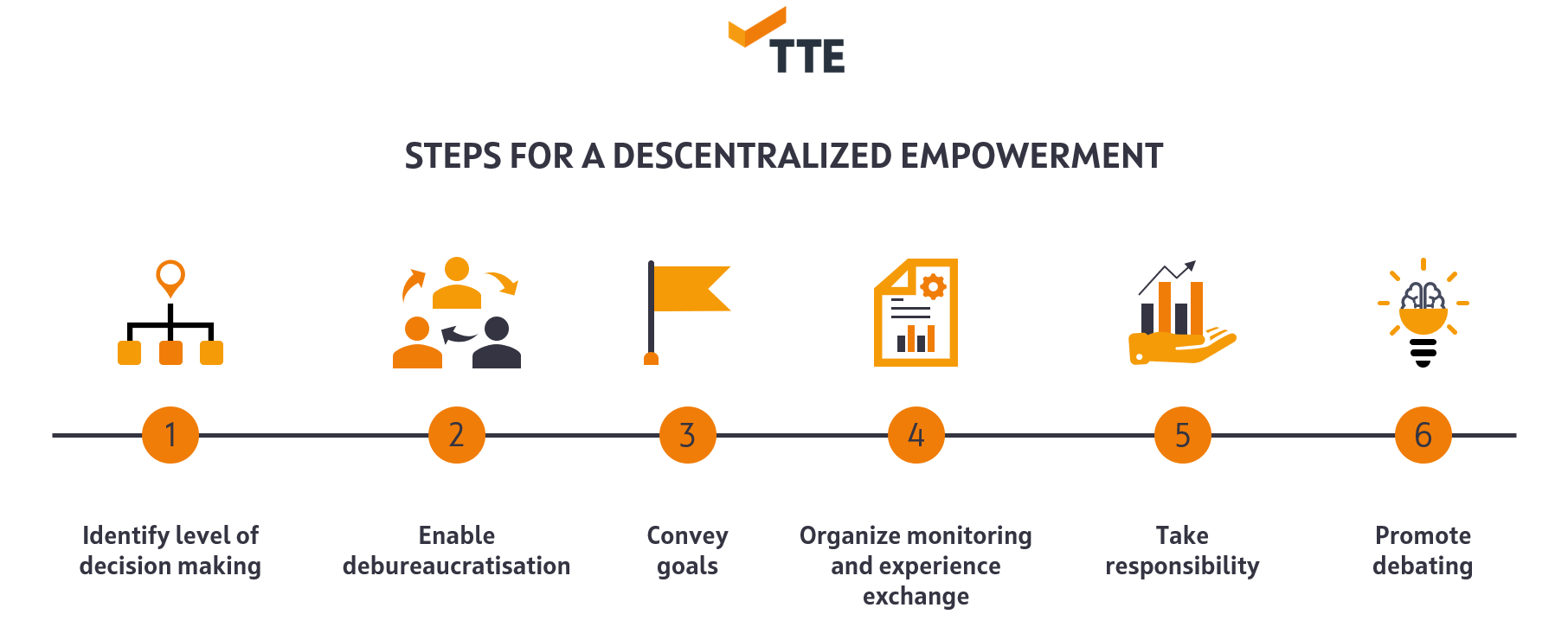
Many companies are currently reacting to the corona crisis by centralizing their decision-making. But this is not suitable for the growing complexity that the leadership of companies faces today. TTE Strategy shows which steps the management team must take to allow for decentralized structures and how to lead successful in this model through empowerment.
The reflex to centralize, and thus speed up, decision-making when the crisis arose was right in several ways. Many companies from all industries have also publicly announced over the past few weeks that they will lead their organizations on a central level more strongly in the future. We are currently observing that this centralized form of company leadership will, however, not remain a phenomenon purely in this time of crisis but could become a mainstay. The danger that we see in this: Bottleneck management, which has just recently and with lots of effort more or less been eliminated in many organizations to make room for more agile structures, threatens to return.
A single person or a small, centralized board can hardly provide adequate answers to every challenge arising due to continually changing parameters though – in terms of the market economy, technology, politics or medicine. Which is why we advise companies to not give up their concept of decentralized leadership – but to design it to be more efficient instead. This means anchoring as many decisions as possible on the company level where the greatest possible competence is based for the respective challenge to be faced. And to empower the division, department or team leaders, as well as any other managers, to make these decisions themselves.
“Empowerment” has frequently been used as a buzzword to date.
In the past, companies have experimented with empowerment within the scope of New Work concepts and changes in the organization and processes. Before the corona crisis, we observed a high level of openness on part of companies toward these new concepts. The bad news: In many companies, empowerment is anchored as a buzzword in management-language, just like agile or disruptive. Only in rare cases is it truly used as a management method. As a result, some empowered department and team leaders feel their hands are tied just like before the time when management learned this new term and included it in their leadership principles.
These are the six steps for guaranteeing decentralized leadership:
To ensure empowerment goes from being an idea to reality, the right framework needs to be set. Our advice is to have a close look to the following topics:

1) Identify the specific right level on which future decisions are to be made:
What may sound profane is actually not so easy to decide in real life. If you select a high level, you run the danger of once again making decisions far from know-how and consequences. If you select a lower level, you lose yourself in details and particular interests that, in the end, lead to a hodgepodge of answers instead of coherent ones. Various approaches are to be selected depending on the organization. It’s recommended that you intensively evaluate and discuss in advance which decisions should be made where in the future.
2) Make local empowerment possible by removing bureaucracy:
It’s not enough to simply announce that one is empowered. Very concrete measures must be taken to also enable this empowerment in practice. These include realigning budgets, shortening approval processes, streamlining reporting. Only when the leeway is real can it also be used.
3) Communicate clear global goals:
Giving the decision-making powers to lower levels doesn’t mean responsibility is being shifted, too. And it also doesn’t mean control is being given away completely. On the contrary, the more decisions that leaders delegate, the clearer they must define their global goals and sub-goals. And ensure that these can also be broken down on the local level. To achieve this, goals must be specific enough that they can be adapted respectively to one’s own tasks. And, at the same time, formulated in a way that is open enough for enabling interpretation leeway.
4) Organize intensive monitoring and exchange of experience:
Once decision-making has been delegated, the level entrusted with this should not be left alone. The task of the top leadership level is to precisely monitor developments. And to establish an exchange of experience among the regions, divisions and levels in which best and worst cases can be talked about.
5) Take responsibility without immediately taking back decision-making competence:
To ensure monitoring doesn’t quickly become controlling, top management must step back to the extent that it can also withstand wrong decisions within a certain tolerance – and not immediately take back decision-making powers. The result of this could be a massive loss in trust and motivation. But management continues to have final responsibility toward all stakeholder groups even when others have made the decisions.
6) Always be available as a sparring partner:
To do justice to this responsibility, direct communication must continue to remain intact, despite the shift in decision-making. But simply in another way. Not “command and control” should be the focus. Instead, the question: How can we as top management help you to make the best decisions? What can we do for you so that you can come up with optimal solutions?


TTE Strategy